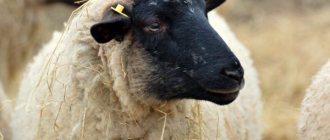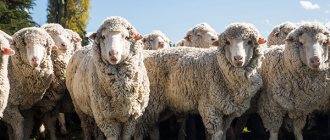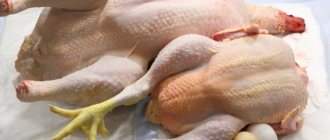The Precos sheep breed belongs to the category of meat and wool and is a distant relative of the Merino sheep. After its appearance, animals were bred mainly on the territory of Ukraine, and later prekos spread to some regions of Russia. This article will introduce readers to the characteristics and description of Prekos sheep, and tell about their advantages and disadvantages.
Prekos sheep breed
Appearance
Sheep of the Prekos breed are characterized by a strong build. They have a stocky body, good support in the form of a strong lower back, and strong limbs. Legs set wide apart. This feature creates the impression that the animals are very massive, with a wide chest and developed bones.
Sheep of the Prekos breed come in a variety of colors. Most often, dark gray representatives are found on farms, and sandy and milky-colored animals are somewhat less common. The rarest color is white.
All four limbs of Precos sheep are covered with a small amount of wool - up to the border with the hock joint. The head is large, the neck is thick and powerful. The tail is short. In purebred sheep, a small number of folds are observed.
Sheep and rams differ in weight. Male individuals reach a height at the withers of 80-90 cm and weigh about 130 kilograms. Females grow up to 70 cm (at the withers) and weigh about 80 kilograms.
The description of the Prekos sheep breed indicates that young animals are able to quickly gain weight - by the age of six months, lambs weigh more than forty kilograms.
The breed is characterized by the absence of horns. Although sheep are considered polled, twenty percent of rams have growths on their heads.
According to the description and characteristics, the Prekos sheep breed differs from others in the following properties:
- Light, strong bones.
- Compact neat ears.
- The neck is dense, without folds, short, powerful.
- The back is wide, the muscle mass is well developed.
- The girth of the sheep's body reaches 120-130 cm.
- The tail is short and shaggy.
- Rams are tall, up to 90 cm at the withers.
Sheep are hardy, able to move tirelessly over long distances. The breed quickly adapts to different climatic conditions. The sheep's temperament is flexible, but timid.
Prekos
The sheep breed is named from the French Précoce - which means early, early ripening. It was bred in France in 1860, and almost simultaneously the same breed appeared in Germany, which was called meat merino. The area where the breed was created is a temperate climate. The basis was the ewes of the Ramboulier breed, which were bred with Leicester rams, German Merinos and English longhair rams. In Russia, sheep of the Prekos breed first appeared in the 20s of the 20th century from Germany; they are mainly bred in the forest-steppe and woodland zones. Sheep of the Prekos breed served as the basis for the development of more than 20 new breeds.
Description of the breed
Sheep of the Prekos breed are considered the leading fine-wool breed for meat and wool production. These are large animals (rams weigh from 100 kg, reaching 115 and above, up to 160 kg, ewes - 55-60 kg, up to 110 kg), with a correct constitution, developed strong bones. The legs are strong, short, and widely spaced. The skin is foldless. The body is round and oblong, the back is flat, the chest is wide and deep. The ewes are polled, the majority of rams are also without horns, about 20% with horns. The coat is up to 10 cm long. On the head, the hair grows to the eyes, on the limbs - to the hock and wrist joints.
Productivity
The wool sheared for rams is 10-12 kg, for queens 5-5.5 kg. Record-breaking rams on breeding farms weigh up to 16.5 kg. The yield of washed wool is 48-52%. The fineness of the wool is 60-64 quality, sometimes 58. The fleece is stamped, rough on the back of the body, dry at the tops. The grease is light cream, creamy. The fiber crimp is correct. The fertility of queens is 140-150%. The average daily weight gain is up to 220 g. By 4 months, rams weigh 34 kg, lambs - up to 30 kg.
Productivity
As indicated in the characteristics, the Prekos sheep breed is famous for its excellent meat. In addition, subject to favorable conditions for keeping and a properly selected diet, you can get an excellent yield of fine wool. It has a spiral structure. Its length reaches ten centimeters. You can collect about nine kilograms of wool from a ram, and five from a sheep.
To increase these results, farmers cross Precos with Australian Merinos.
According to the characteristics, the Prekos sheep breed is characterized by rapid growth. By the age of four months, young individuals already weigh about 40 kilograms. The average daily weight gain is three hundred grams. Adults with good fattening can grow up to 120 kilograms. There are record holders among representatives of the breed, whose weight reached 160 kg.
To obtain excellent lamb, it is recommended to slaughter it at nine months of age.
Wool-meat type lambs
The fine-wool wool-meat breed has greater weight and size than the wool breed. There are no obvious folds on the skin, but the body structure of this type is more powerful.
To date, there are 8 known breeds:
- Askaniyskaya;
- Caucasian;
- Transbaikal;
- Kyrgyz;
- Yuzhnouralskaya;
- North Caucasian.
The fine-fleece sheep of the wool-meat type has a large body with well-developed muscles. This species is also distinguished by a good layer of fat and high-quality meat. Rams gain weight up to 110 kg, and sheep can weigh a maximum of 65 kg.
Fine wool sheep of wool-meat type
A male can produce 15 kg of wool in one year, and a female can produce 6 kg. The length of one hair of this type is 9 cm. Its main advantage is high quality meat. The wool-meat type can most often be found in different regions of Ukraine, because these animals are adapted to a temperate climate.
Advantages of the breed
Prekos sheep and lambs are considered calm animals. They are valued not only for their wonderful wool and tasty meat. These animals also have other advantages. As stated above, they gain weight quickly. Ewes are highly fertile - there are about 150 lambs per hundred females.
The advantage of the breed is considered to be the excellent adaptability of individuals to different conditions and climate. Sheep produce excellent wool with a density of up to 500 hairs per square centimeter.
Sheep breeders' advice
Farmers speak positively about the productivity of Prekos sheep and give the following recommendations to novice sheep farmers:
- You should not cross Prekos with other breeds at an early age: the offspring will be weak and unproductive.
- To form a herd, lambs should be purchased at least 2 months old. In this case, it is advisable to choose individuals from among twins: in the future, this guarantees the fertility of the sheep.
- Sheep must be sheared twice a year. The wool will be of higher quality.
- The highest quality and most delicious meat can be obtained by slaughtering young animals at the age of 9 months.
Prekos sheep are a worthy breed for private breeding due to their increased fertility and productivity in meat and wool.
The video shows Prekos sheep at an exhibition.
Flaws
Despite the advantages, Prekos sheep also have disadvantages. These include:
- Low wool yield is about 50%, which is due to the fact that not all areas of the body have wool.
- The cut is uneven.
- In certain areas of the body, the fibers differ in length and density.
In farms where purebred breeding is carried out, attention is paid to the culling of individuals. Those that do not meet breed standards are sent to slaughter. These are lambs that slowly gain weight, individuals with various defects, including underdevelopment of the genital organs and low sexual activity.
Sheep Prekos
The Precos sheep breed belongs to the category of meat and wool and is a distant relative of the Merino sheep. After its appearance, animals were bred mainly on the territory of Ukraine, and later prekos spread to some regions of Russia. This article will introduce readers to the characteristics and description of Prekos sheep, and tell about their advantages and disadvantages.
Prekos sheep breed
Content
The Prekos breed is not particularly demanding in terms of care and maintenance. During the warm season, animals are constantly in the fresh air. In the mornings and evenings they are grazed on pastures, and at midday (during the sun) they are placed under a canopy. If climatic conditions allow, year-round grazing can be practiced. In regions with cold winters, animals are kept in pens at temperatures not lower than +5 degrees Celsius. In the barns where the queens and lambs are kept, the temperature is maintained at least +15 degrees.
Sheep, like other artiodactyls, are afraid of high humidity and drafts. Such conditions negatively affect the health of animals. To create a microclimate suitable for the breed, a ventilation system is installed in the room. It provides a flow of fresh air and removes excess moisture.
The floors in the pen are covered with straw or hay. The flooring is changed once a week, but more often. Be sure to process equipment used to care for animals.
The pen is equipped with a place where animals receive food.
Features and Signs
Previously, in England and New Zealand, sheep's wool was considered a luxury and was highly valued, but those days have passed, and they have been replaced by a popular meat breed of sheep. They have tender and tasty meat that does not have a specific smell.
And during the USSR period, people very rarely ate lamb, since it had a specific smell and taste, but this only applied to wool breeds. In those days, humanity sought to breed sheep solely for wool and sheepskin. During the collapse of the USSR, almost all the sheep suffered, which, due to lack of money, began to be slaughtered and sold.
But even despite this, sheep managed to survive, meat breeds entered the cycle and became popular in Russia. The Gorky breed still needs specialists to this day so as not to disappear completely.
The difference between meat breeds and others is that they gain weight quickly. A lamb that reaches four months of age weighs as much as half an adult cattle. In one year, the ewe will weigh 90% of an adult.
Nutrition
According to the description, keeping the Prekos sheep breed is not difficult. In summer, sheep eat green feed obtained from pastures. This is their main diet in the warm season. In the fall, animals begin to be fed additionally, introducing into the diet:
- Bran.
- Silage.
- Cereals.
- Vegetables, fruits, root vegetables.
- Cake.
Vitamins are included to enhance immunity. Throughout the year, sheep should have free access to mineral supplements in the form of lick salt, fish or bone meal. They are necessary to improve the quality of the coat and appearance.
Sheep must also be provided with constant access to fresh water.
Karachaevskaya
A universal variety that is famous for its meat, dairy and wool productivity. There are three types of dark color:
- Tumak is a black sheep, hornless. Meat direction.
- Qara-muyuz is a black-haired silky subspecies, straight or wavy braids. Horned.
- Kökbash – the largest representatives, gray wool.
Qara-muyuz produces wool of good quality. Tumak boasts both the quality of wool and great weight. Kekbash gives the highest meat yield of the three “brothers”.
The meat of Karachay black species is popular all over the world. For example, in Bordeaux (France) there is still a restaurant serving dishes only from Karachay sheep. To do this, the owners breed them themselves, maintaining a constant population in the local herd.
Interesting fact! The Karachay breed is credited with remarkable immunity, unique among animals due to its selective nature.
These animals are considered unpretentious and tolerant of different weather conditions.
Breeding
Prekos females are highly fertile. Every second queen gives birth to two lambs.
The breed is characterized by early sexual development. Already at eight months of age, ewes are ready to mate and bear offspring. But mating is recommended when they are one year old.
According to farmers' observations, the most productive age for ewes is from two to five years. Then productivity decreases. For breeding purposes, the queen can be used for up to nine years.
Lambs
At birth, babies weigh up to five kilograms. With little feed costs, they quickly gain weight. Already at 4 months, the young weigh about 40 kilograms, and at six months - 55 kg.
Throughout the entire period of the breed’s existence, breeders are constantly working to improve its characteristics. With proper selection, the percentage of fertility increases annually by 2-4%. The main thing in this matter is to follow some rules:
- You should not crossbreed too young individuals, as they produce weak offspring.
- When animals mate, multiple pregnancies produce offspring that are highly fertile.
- When purchasing adult animals, preference should be given to sheep at least two months old.
After birth, the lambs quickly rise to their feet and behave actively. They have a thick coat of fur that becomes even denser as they develop.
Ewes do not have problems with feeding their offspring, since the breed has good milk production. Lambs are weaned when they reach a weight of 30-35 kg.
When breeding Precos sheep, it is important to provide the young with sufficient nutrition, especially in the first months of life, since it is during this period that intensive weight gain occurs, and as they grow older, the growth rate decreases.
Romanovskaya, 50-100 kg
In the 18th century, in the Yaroslavl province, the Romanov sheep appeared on peasant farms.
She was one of the most outstanding in terms of fur coat qualities and received this name because... initially spread in the Romanovo-Borisoglebsky district. The queens of this breed are small, weighing up to 55 kg, but some individuals grow up to 90 kg, while the rams are much heavier - from 65 to 75 kg, sometimes they weigh 100 kg. They are kept for the lightest, most elegant and durable sheepskins.
The skin of lambs 6-8 months old is especially valued. Babies of this breed have a black coat, but from the second to fourth week it becomes lighter, and by five months it becomes depigmented.
But, despite the fact that they are bred for sheepskin, they are also valued as sources of meat, because... Already at 100 days, lambs can weigh up to 22 kg, and at 9 months - 40 kg.











